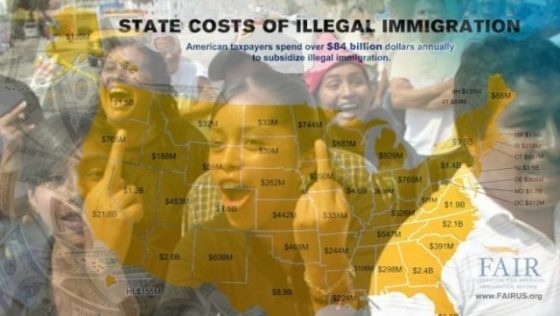By: Denise Simon | Founders Code
Foreign nationals are increasingly gaining the ability to influence American elections more directly. They’re being granted the right to vote.
From Boston, where the city council is debating the move, to San Francisco, where noncitizens gained the right earlier this month in school-board elections, jurisdictions are looking to expand the boundaries of the electorate beyond its citizens.
***
Primer: This was compiled by Yale and MIT. Have you considered how many U.S. House Representatives exist from districts where illegals and foreign nationals are the majority? 20? 10? 40?
Context: The Democrats on the Dreamer thing were and are willing to sacrifice the interests of 325 million Americans in order to gain unconditional amnesty for 3.4 million illegal aliens.
In part: Our analysis has two main outputs. First, we generate what we call our conservative estimate, using parameter values that intentionally underestimate population inflows and overestimate population outflows, leading to estimates that will tend to underestimate the number of undocumented immigrants. Our conservative estimate for 2016 is 16.7 million, well above the estimate that is most widely accepted at present, which is for 2015 but should be comparable. Our model, as well as most work in the literature, indicates that the population size has been relatively stable since 2008; thus 2015 and 2016 are quite comparable. For our second step, recognizing that there is significant uncertainty about population flows, we simulate our model over a wide range of values for key parameters. These parameter values range from very conservative estimates to standard values in the literature. We sample values for each key parameter from uniform distributions over the ranges we establish. In our simulations, we also include Poisson population uncertainty conditional on parameter values, thus addressing the inherent variability in population flows. Our simulation results produce probability distributions over the number of undocumented immigrants for each year from 1990 to 2016. The results demonstrate that our conservative estimate falls towards the bottom of the probability distribution, at approximately the 2.5th percentile. The mean of the 2016 distribution is 22.1 million, which we take as the best overall estimate of the number of undocumented immigrants based on our modeling approach and current data. We also show the variability in our model based on the simulations for each year from 1990 through 2016.
***
Population inflows are decomposed into two streams: (I) undocumented immigrants who initially entered the country legally but have overstayed their visas; and (II) immigrants who have illegally crossed the border without being apprehended. We describe our approach for each source, explain the basis for our assumptions and why they are conservative, and list parameter ranges for the simulation.
(I) Visa overstays are estimated using Department of Homeland Security (DHS) data for 2016, the first year for which visa overstays were comprehensively measured [5]. To apply this data in our context we also gather data for non-immigrant visas issued for all years from 1990 [6]. For our conservative estimate we assume that for each year the rate of overstays was equal to the 2016 rate. Calibration of our model shows that this assumption is in fact quite conservative. In particular, approximately 41% of undocumented immigrants based on the current survey data approach are visa overstayers [7], which translates to a visa overstay population of 4.6 million in 2015. Our model, however, predicts the number of overstayers to be less than this (even though our overall estimate of the number of undocumented immigrants is higher). That is, in our model most undocumented immigrants are not overstayers, and the model produces an estimate of the number of overstayers below the estimate produced in the conventional approach based on survey data. We compute that we would need to set the visa overstay rate above the DHS 2016 rate, specifically 1.1 times that rate, for our conservative estimate to generate as many overstayers as the 4.6 million in the 11.3 million estimate. Since many overstayers leave or adjust their status within a few months of their visa expiration date, we make a further conservative adjustment and count as overstayers only those individuals who have overstayed more than 1 year. For the simulation, we set the visa overstay rate equal to the 2016 rate multiplied by a uniform draw from the range [0.5,1.5]; consistent with the discussion above, this is a relatively conservative range.
(II) Illegal Border Crossers: We estimate illegal border crossers through application of the standard repeated trials (capture-recapture) model [8–10]. The model requires as inputs statistics on the total number of border apprehensions, the number of individuals apprehended more than once in a year (recidivist apprehensions), and estimates of the deterrence rate—the fraction of individuals who give up after being apprehended and do not attempt another crossing. Given these inputs, the repeated trials model generates estimates of: (i) the apprehension rate—the probability an individual is caught trying to cross the border; and (ii) the total number of individuals who are not apprehended (they may be caught one or more times but cross successfully on a later attempt) and enter the interior of the country illegally—the number of illegal border crossers in a year. We discuss data sources and potential weaknesses of this approach here; more information and mathematical details are provided in the Supporting Information.
DHS [10, 11] provide figures for the total number of border apprehensions for every year in our timespan. They also provide information on the number of recidivist apprehensions and estimates of the deterrence rate for every year from 2005. Based on these figures and estimates they provide an estimate of the apprehension rate for each year from 2005 to 2015. Their estimate is 35% for 2005 and increases steadily, to above 50% by the end of the sample period. From their estimates, we are able to derive directly estimates of the number of illegal border crossers for each of these years. For earlier years (1990 to 2004) we must make further assumptions. Our assumptions are about the apprehension and deterrence rates since these have been addressed in the literature; in turn, we are able to generate estimates of the number of illegal border crossers in earlier years based on these assumptions (see the Supporting Information for analytic details).
Most experts agree that the apprehension rate was significantly lower in earlier years [12, 13]. A recent study [12] using data from the Mexican Migration Project estimates this rate for every year from 1990 to 2010; estimates in the 1990’s begin from the low twenties and range upwards to approximately 30%. A second study estimates the rate for 2003 at around 20% [13]. Given these estimates, and the general view that apprehension rates have risen, for our conservative estimate we assume that the apprehension rate in years 1990-2004 was equal to the average rate in years 2005-10 or 39%; this is well above the rates discussed in the literature for earlier years and thus tends to reduce our estimate of the number of undocumented immigrants since it implies a larger fraction are apprehended at the border. For our simulation we assume a uniform distribution over the range [0.25,0.40] for the earlier years, still above the average rates in the literature for these years.
Additional facts support the view that the apprehension rate has increased in recent years. The number of border agents has increased dramatically over the timespan of our analysis [14], and the number of hours spent by border agents patrolling the immediate border area has increased by more than 300% between 1992- 2004 [15]. Further, new infrastructure (e.g., fences) and technologies (e.g., night vision equipment, sensors, and video imaging systems) were also introduced during this period [15]. Thus the apprehension rate we use for earlier years almost certainly overstates the actual apprehension rate and therefore underestimates the number of successful crossings. However, we note that these additional border resources may have been concentrated in certain locations and it remains a possibility that apprehension rates were higher in earlier years. We note finally that in using data only on Southern Border crossings we again are conservative in our approach, not accounting for illegal crossings along other borders.
Notwithstanding our view that we make conservative choices in setting up our model and parameter values, we acknowledge that border apprehension rates for the 1990’s are not based on as well-developed data sources as estimates for more recent years. Thus it remains a possibility that these rates are higher than we believe. One aspect of this uncertainty concerns deterrence. When deterrence is higher border crossings will fall. Most researchers believe deterrence has increased in recent years [8, 12]. We note that reference [12] estimates that the probability of eventual entry after multiple attempts on a single trip in the 1990s is close to one, indicating almost no deterrence in the earlier period. One piece of evidence in support of this is data on the voluntary return rate, which refers to the percentage of individuals apprehended at the border who are released back to their home country without going through formal removal proceedings and not being subjected to further penalties. Voluntary returns are thus not “punished” and thus are less likely to be deterred from trying to cross the border in the future, compared with individuals who are subjected to stronger penalties. The voluntary return rate has fallen in recent years, from 98% between 2000 and 2004 to 84% between 2005 and 2010. Thus, at least based on this measure deterrence efforts have increased. However, this does not conclusively demonstrate that deterrence was lower in earlier years and it remains a possibility that it was higher, which would tend to reduce our estimates of the number of undocumented immigrants. In conclusion we note that although there is much uncertainty about the border apprehension rate, it would have to be very high, above 60% for earlier years, in order to generate estimates of the 2015 population of undocumented immigrants in the range of the current widely accepted estimate of just over 11 million (this is based on analyzing our model using the conservative estimate values for all other parameters). This seems implausible based on our reading of the literature.
Population outflows
Population outflows are broken into four categories: (I) voluntary emigration; (II) mortality; (III) deportation; and (IV) change of status from unauthorized to lawful.
(I) Voluntary emigration rates are the largest source of outflow and the most uncertain based on limited data availability. It is well accepted that voluntary emigration rates decline sharply with time spent in the country [16]; thus we employ separate emigration rates for those who have spent one year or less in the U.S., 2-10 years, or longer. We use the following values for our conservative estimate. First, for those who have spent one year or less we assume a voluntary emigration rate of 40%. This estimate is based on data for the first-year visa overstay exit rate (the fraction of overstayers who left the country within one year from the day their visa expired) for 2016 [17], which is in the lower thirty percent range (the rate for 2015 is similar). We note that the rate for visa overstayers is very likely a substantial overestimate for illegal border crossers, who are widely viewed as having a lower likelihood of exiting in the first year, especially in more recent years [12]. The 40% first-year emigration rate that we assume is well above the standard values in the literature [4, 12, 16, 18], which range from 1% to 25%. Hence this assumption contributes to making our estimate of the number of undocumented immigrants in the country a conservative one. For years 2-10 we assume a rate of 4% per year. This is the upper bound among estimates in the literature, which lie between 0.01 to 0.04 [4, 16, 18]. Lastly, for years 10 and above, published estimates of the emigration rate typically fall around 1%; we set this rate to 1% per year in line with these estimates. Note that given the extremely high 40% emigration rate that we assume for those who have only been in the country for one year or less, overall annual emigration rates in our model simulation are significantly higher than those found in the literature or government sources. To further enhance the conservatism of our model, we assume that all undocumented immigrants present at the beginning of 1990 have been here for only one year. Read the whole report here.


















